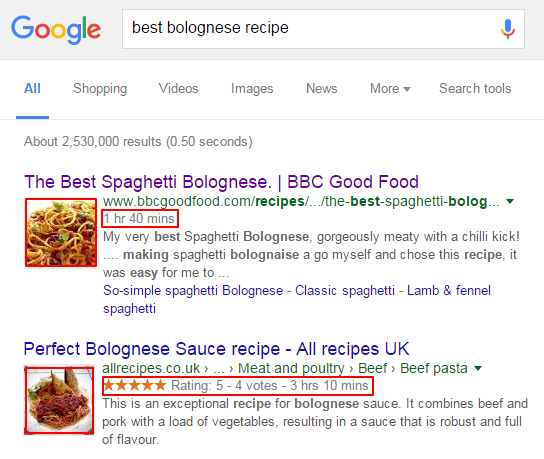Blog
SOZO’s Top Optimisation Tips for Google
Optimise for RankBrain with structured data
Google processes over one trillion searches a year and around 15% of those queries it had never seen before – enter RankBrain, Google’s artificial intelligence ranking engine.
In Oct 2015 Google announced, via an interview with Bloomberg, that it has integrated an artificial intelligence engine named RankBrain into their main search algorithm Hummingbird and this has become the third most important ranking factor, making it a crucial area for SEO. They didn’t point out what the top two ranking factors were, but it’s mostly to be links and content (words) on the site.
The main objective of RankBrain is to better understand the intent of a search and to provide better results for the 15% of searches they’ve never handled before. So a good understanding of RankBrain is crucial for high performing SEO. Prior to RankBrain the search algorithm mainly contained methods which all stem back to human intervention, such as creating synonym and stemming lists, relationships and connections to deliver better results.
As the third most important ranking factor, we can assume RankBrain is not just being used to provide better results for new searches, but to provide better results for all searches. So how do you optimise your site for SEO…
How to optimise for RankBrain?
To give RankBrain what it needs, sites need to utilise structured data extensively. In the past, sites could get by without marking up their content, but with the introduction of RankBrain and the increasing use of rich snippets in the search results, it can no longer be left on the SEO subs bench, it needs to be promoted to the A-team.
As well as improving your rankings with the use of Structured Data it can also mean rich snippets are displayed in the search results which can make your site stand from the rest. See below.

Increased importance of mobile optimisation for SEO
The facts for SEOs
- In April 2015, Google launch Mobilegeddon, their most significant mobile algorithm update.
- In May 2015 Google reported that ‘more Google searches take place on mobile devices than on desktop computers in 10 countries, including the US and Japan’.
- In October 2015 Google announced an initiative to make web sites load even faster on mobile devices via a new, open source technology they have developed called Accelerated Mobile Pages.
The issue with Accelerated Mobile Pages (AMP) is you will probably have to maintain two code bases for your site, which for most, is cost prohibitive. Whatever the take-up for AMP, it’s another sign that Google is giving added weight to the load speed of mobile sites as one of their ranking factors, so it’s time to get serious about SEO for mobile search and mobile users.
What are the web browsing differences between mobile and desktop?
Most mobile users browse in a portrait and desktop users in landscape. For this reason mobile design should be given appropriate consideration at the design stage of a project. Despite the massive and increasing use of mobile devices for browsing and shopping online, mobile design is not getting the attention it deserves and is often an afterthought and something that just happens last thing before a site goes live. For SEO purposes, ensure you have a well-optimised, responsive web design.
Optimise for Voice Search
Our third SEO tip has cross over with our first two. As you might expect, voice search is increasing in-line with mobile usage and is will continue to do so. To optimise for voice search we first need to consider how it is used. It’s often used for direct questions like ‘What is a habanero pepper?’ or for local searches like ‘Show me a rock climbing wall nearby’. You can also use follow up questions, so you can then say ‘Show me directions there’, ‘What time does it open?’.
How to optimise your SEO for voice search
- Review your long tail search queries and consider the questions your users often want answers to and create content for this.
- Optimise for Googles Knowledge Graph, which is their system for organising information about entities (people, places, businesses etc), by utilising structured data.
- Optimise for mobile (see above) as the vast majority of voice searches are from mobiles.
- Mobile search has a strong local intent (40%-80%) so it’s important for regional businesses to optimise for local search.
The image below shows rich snippets along with an additional related questions panel which further supports the need to focus on long tail questions your users might have for SEO.

In summary
The most significant SEO factors are the introduction of the RankBrain AI as the third most influential ranking factor and the increasing dominance of mobiles for search and online shopping. The ways we can optimise SEO for these are to make our mobile sites as fast as possible and design specifically for the mobile user to increase conversion rates. Make extensive use of structured data to feed RankBrain and Google Knowledge Graph what it needs to provide targeted voice and desktop search and look at provided specific content to users questions.
Read: What is the average bounce rate for an ecommerce website?
you might also like… you might also like…
Sign up to our newsletter
Keen to learn more about how to grow online?
Get our latest advice articles, masterclass
videos and webinars.
curious for more?













